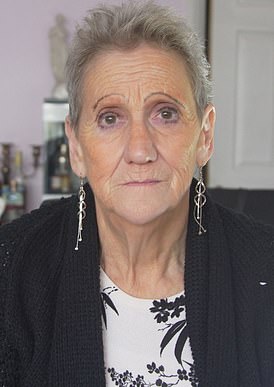Fascinating interactive graph shows how UK cancer survival rates lag 15 YEARS behind those in Australia, Canada and Norway
Britain’s survival rates for five common cancers lag drastically behind those of other high-income countries, shocking data has revealed.
Only 7.9 percent of Britons diagnosed with pancreatic cancer in 2014 could still be alive five years later.
In Australia the chances almost doubled: 14.9 percent.
It comes as top experts today warned that Britain is woefully 15 years behind other countries due to a lack of chemotherapy and radiotherapy.
The damning report found thousands of patientsWe are being denied potentially life-saving treatment NHS.
Even patients who did receive treatment had to wait longer, increasing the risk of their disease spreading and reducing their chances of survival.
Two new studies, part-funded by Cancer Research UK and published in the Lancet Oncology, show that people in Britain are less likely to be treated with chemotherapy and radiotherapy than in Norway, Canada and Australia. Graph shows the average chemo use for all types of cancer
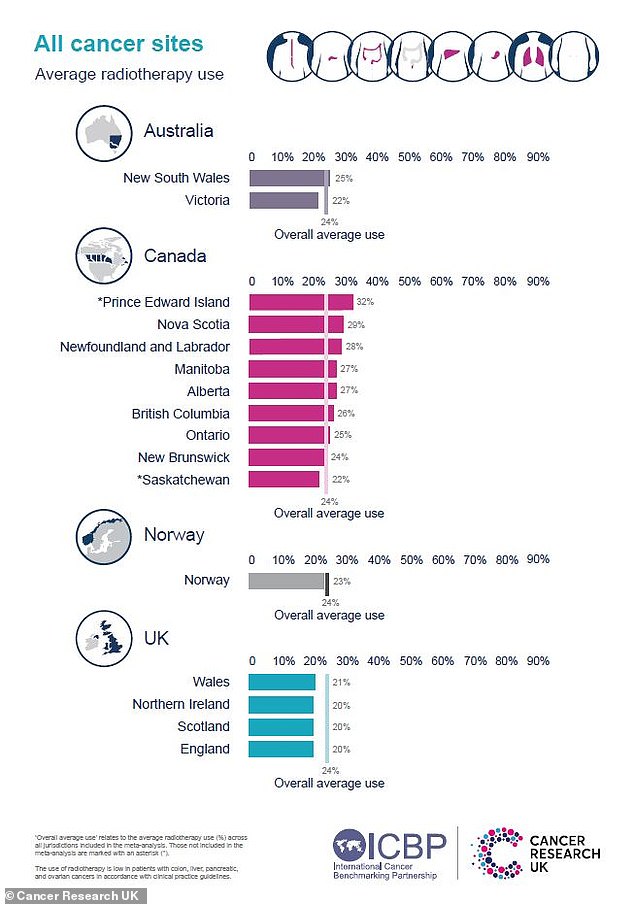
The study was conducted by the International Cancer Benchmarking Partnership and is the first to examine treatment differences for eight types of cancer on three continents. Graph shows the average radiotherapy use
Leading experts denounced the ‘missed opportunity’ for cancer patients and demanded urgent action to tackle the crisis.
Survival rates depend entirely on the type of cancer, with some known to be more aggressive than others.
The specific subgroup of cancer may also have an effect.
The figures, which assess rates between 2010 and 2014, show that Britain was the worst of any country tested for cancer of the pancreas, stomach, lungs, bowel and ovaries.
The intestines had the highest survival rate after five years: 58.9 percent.
However, patients in Australia, Canada and Norway had significantly better odds, with an average rate of seven in ten (70.8 percent), two-thirds (66.8 percent) and 65.4 percent respectively.
Ovarian health fared no better, with only 37.1 per cent of Brits diagnosed with cancer between 2010 and 2014 expected to be alive five years later.
In contrast, the percentage was 46.2 percent, 43.2 percent and 40.3 percent in Norway, Australia and Canada.
The UK five-year survival rate for stomach cancer was also 20.8 percent in 2010-2014.
Australia recorded 32.8 percent, while Canada and Norway reported figures of 29.8 percent and 26.9 percent.
It comes as new data released today shows Britain is ‘still around 10 to 15 years behind’ countries such as Australia, Canada and Norway, which are much more likely to give patients chemotherapy and radiotherapy.
Leading experts warned that the findings help explain why cancer survival rates in Britain are drastically lower than in other developed countries.
Dr. John Butler, clinical lead for the International Cancer Benchmarking Partnership and ovarian cancer surgeon, said: ‘For many aggressive cancers, such as ovarian, lung and pancreatic cancer, it is crucial that people are diagnosed and start treatment as soon as possible .
‘Lower use of chemotherapy and radiotherapy in Britain could affect people’s chances of survival, especially for older patients.
‘Although we have made progress, the latest benchmark has shown that cancer survival rates in Britain are still around 10 to 15 years behind leading countries.
‘This study captures missed opportunities for patients in Britain to receive life-extending treatment.’
The researchers from University College London examined data from 780,000 people to compare how treatment for eight types of cancer differed between 2012 and 2017 in Australia, Canada, Norway and the United Kingdom.
Just under a third (31.5 percent) of British patients received chemotherapy, compared with 38.5 percent in Canada, 39.1 percent in Norway and 42.1 percent in Australia.
Meanwhile, 19.8 percent of British patients received radiotherapy, compared with 25.7 percent in Canada, 22.5 percent in Norway and 23.9 percent in Australia.
The treatment lottery has been especially grim among older patients, which critics have described as “blatant ageism.”
Only 2.4 percent of British patients aged 85 and over received chemotherapy, compared with 8.1 percent in Australia and 14 percent in parts of Canada.
The studies, funded by Cancer Research UK and the International Cancer Benchmarking Partnership, were published in Lancet Oncology.
Samantha Harrison, from Cancer Research UK, said: ‘What we can say now is that treatment clearly plays a role in survival differences.
‘The countries with better outcomes tend to have both higher and faster uptake of treatments.
‘The use of chemotherapy and radiotherapy is less in this country, especially in older patients, and this has an impact on survival.’
Caroline Abrahams, director of Age UK, added that the research found that older people are prone to ‘unequal treatment’ within the NHS.
She said: ‘While it is true that older people are more likely to live with multiple conditions, that alone is not a valid reason to rule them out.
‘With the right support and clinical expertise, many older people can and will still choose to benefit from cancer treatment.’
Dennis Reed, of over-60s campaign group Silver Voices, said: ‘The NHS has shown time and time again that it is systematically age-sensitive.
‘The older you get, the less likely you are to be diagnosed in time, and even then the chances of needing medical or surgical intervention are much smaller.
In addition to the wide disparities in treatment, British patients faced some of the longest wait times to start cancer care, typically 81 days in Labour-run Wales.
Health leaders have consistently warned that a range of key cancer targets have gone unhit in recent years.
They also estimate that 40,000 cases of cancer went undiagnosed in the first year of the pandemic alone.
Official NHS data for December on cancer waiting times shows that only seven in ten (74.2 percent) of patients urgently referred for suspected cancer were diagnosed or ruled out with cancer within 28 days. The goal is 75 percent.
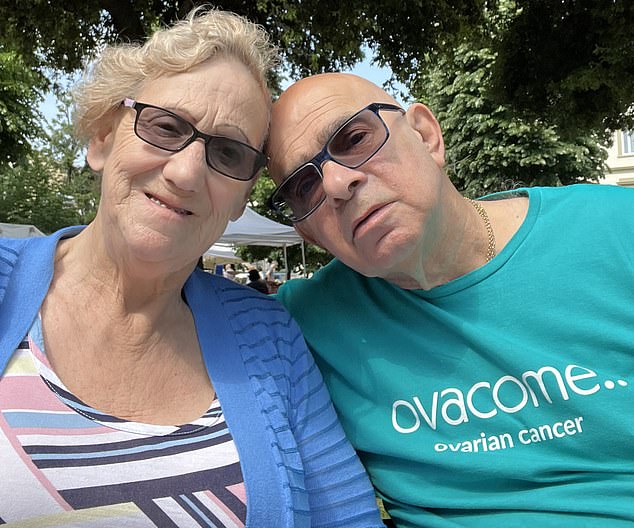
Anne Shaw (pictured with husband Louis) has won a six-figure payout after NHS medics failed to detect her cancer and ease her concerns for two years
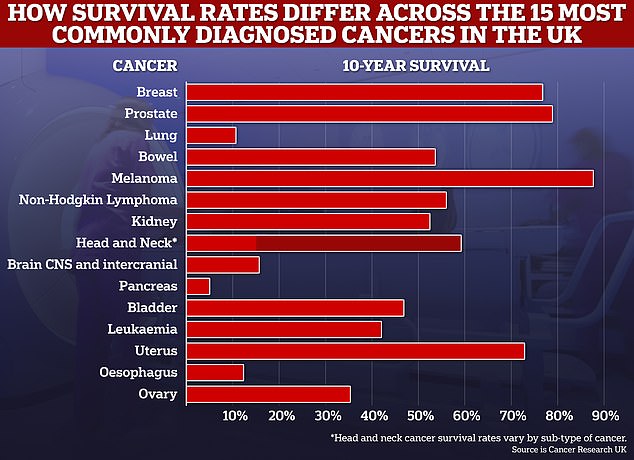
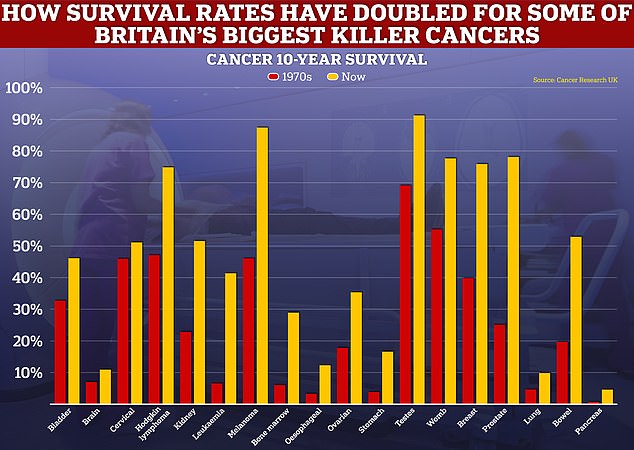
While the level of progress in cancer survival has been rapid in some forms of the disease, such as breast and prostate cancer, others, such as those in lung and pancreas, have improved only at a snail’s pace.
Only nine in ten (91.1 percent) wait a month or less to start their first cancer treatment after deciding whether to proceed with surgery, chemotherapy or radiotherapy.
The target is 96 percent, but this has never been achieved.
An NHS spokesperson said: ‘More people than ever are being diagnosed with cancer at an early stage and there are more treatment options available.’
A spokesperson for the Department of Health and Social Care said: ‘These figures only cover the period 2012-2017.
‘Since then we have invested significantly in the diagnosis and treatment of cancer, including £162 million for radiotherapy equipment and £2.3 billion to launch 160 Community Diagnostic Centers across England, which will help us achieve our target of treating 75 per cent of all detect cancers. in phase 1 or 2 in 2028.’
They added: ‘Reducing waiting lists is one of the government’s five top priorities, and we have treated record numbers of patients over the past year.
‘Survival rates are also improving for almost all types of cancer, and we will soon legislate to create the first smoke-free generation – the biggest public health intervention in decades.’

